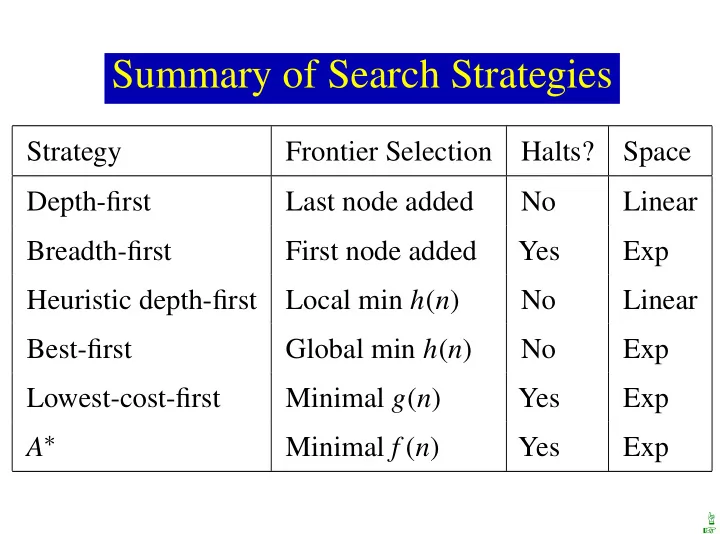

Summary of Search Strategies Strategy Frontier Selection Halts? Space Depth-first Last node added No Linear Breadth-first First node added Yes Exp Heuristic depth-first Local min h ( n ) No Linear Best-first Global min h ( n ) No Exp Lowest-cost-first Minimal g ( n ) Yes Exp A ∗ Minimal f ( n ) Yes Exp ☞ ☞
Cycle Checking s ➤ You can prune a path that ends in a node already on the path. This pruning cannot remove an optimal solution. ➤ Using depth-first methods, with the graph explicitly stored, this can be done in constant time. ➤ For other methods, the cost is linear in path length. ☞ ☞ ☞
Multiple-Path Pruning s ➤ You can prune a path to node n that you have already found a path to. ➤ Multiple-path pruning subsumes a cycle check. ➤ This entails storing all nodes you have found paths to. ☞ ☞ ☞
Multiple-Path Pruning & Optimal Solutions Problem: what if a subsequent path to n is shorter that the first path to n ? ➤ You can remove all paths from the frontier that use the longer path. ➤ You can change the initial segment of the paths on the frontier to use the shorter path. ➤ You can ensure this doesn’t happen. You make sure that the shortest path to a node is found first. ☞ ☞ ☞
Multiple-Path Pruning & A ∗ Suppose path p to n was selected, but there is a shorter path to n . Suppose this shorter path is via path p ′ on the frontier. Suppose path p ′ ends at node n ′ . cost ( p ) + h ( n ) ≤ cost ( p ′ ) + h ( n ′ ) because p was selected before p ′ . cost ( p ′ ) + d ( n ′ , n ) < cost ( p ) because the path to n via p ′ is shorter. d ( n ′ , n ) < cost ( p ) − cost ( p ′ ) ≤ h ( n ′ ) − h ( n ). You can ensure this doesn’t occur if | h ( n ′ ) − h ( n ) | ≤ d ( n ′ , n ) . ☞ ☞ ☞
Monotone Restriction ➤ Heuristic function h satisfies the monotone restriction if | h ( n ′ ) − h ( n ) | ≤ d ( m , n ) for every arc � m , n � . ➤ If h satisfies the monotone restriction, A ∗ with multiple path pruning always finds the shortest path to a goal. ☞ ☞ ☞
Iterative Deepening ➤ So far all search strategies that are guaranteed to halt use exponential space. ➤ Idea: let’s recompute elements of the frontier rather than saving them. ➤ Look for paths of depth 0, then 1, then 2, then 3, etc. ➤ You need a depth-bounded depth-first searcher. ➤ If a path cannot be found at depth B , look for a path at depth B + 1. Increase the depth-bound when the search fails unnaturally (depth-bound was reached). ☞ ☞ ☞
Iterative Deepening Complexity Complexity with solution at depth k & branching factor b : level breadth-first iterative deepening # nodes 1 1 k b b 2 2 1 k − 1 b k − 1 k − 1 1 2 b k 1 1 k � 2 ≤ b k � b ≥ b k b − 1 ☞ ☞ ☞
Direction of Search The definition of searching is symmetric: find path from start nodes to goal node or from goal node to start nodes. Forward branching factor: number of arcs out of a node. Backward branching factor: number of arcs into a node. Search complexity is b n . Should use forward search if forward branching factor is less than backward branching factor, and vice versa. Note: sometimes when graph is dynamically constructed, you may not be able to construct the backwards graph. ☞ ☞ ☞
Bidirectional Search ➤ You can search backward from the goal and forward from the start simultaneously. ➤ This wins as 2 b k / 2 ≪ b k . This can result in an exponential saving in time and space. ➤ The main problem is making sure the frontiers meet. ➤ This is often used with one breadth-first method that builds a set of locations that can lead to the goal. In the other direction another method can be used to find a path to these interesting locations. ☞ ☞ ☞
Island Driven Search Idea: find a set of islands between s and g . s − → i 1 − → i 2 − → . . . − → i m − 1 − → g There are m smaller problems rather than 1 big problem. This can win as mb k / m ≪ b k . The problem is to identify the islands that the path must pass through. It is difficult to guarantee optimality. You can solve the subproblems using islands � ⇒ hierarchy of abstractions. ☞ ☞ ☞
Dynamic Programming Idea: for statically stored graphs, build a table of dist ( n ) the actual distance of the shortest path from node n to a goal. This can be built backwards from the goal: 0 if is _ goal ( n ), dist ( n ) = min � n , m �∈ A ( |� n , m �| + dist ( m )) otherwise. This can be used locally to determine what to do. There are two main problems: • You need enough space to store the graph. • The dist function needs to be recomputed for each goal. ☞ ☞
Recommend
More recommend